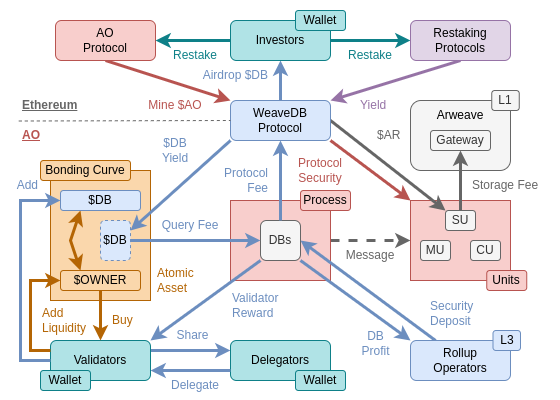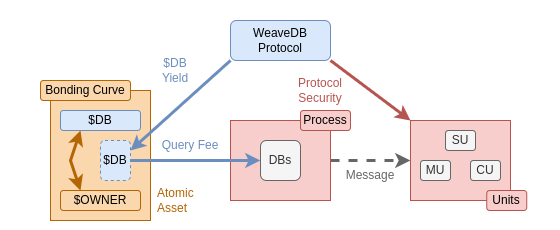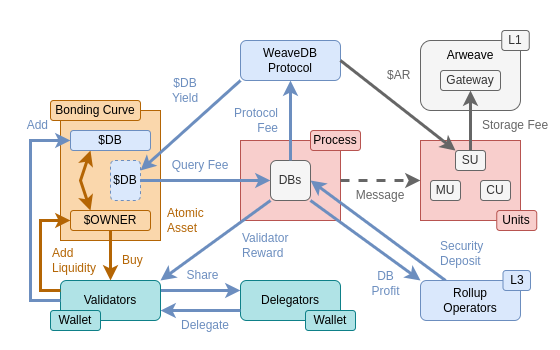Tokenomics ($DB)
WeaveDB employs a restaking mechanism on Ethereum and AO, inspired by EigenLayer, to secure rollup operations while ensuring database self-sustainability. Initially, rollups will be the first actively validated service, with plans to extend the same mechanism to other protocols, such as token bridges, zkRollups, and zkOracles, in the future.

Restaking Yield & $DB Airdrop
The WeaveDB protocol derives its primary value from restaking other tokens. Stakers can restake tokens like $stETH and $DAI to the AO staking contract or other approved tokens to the protocol-owned restaking contract. In return, WeaveDB accrues restaking yields and distributes $DB tokens as a reward to restakers through periodic airdrops.

The restaking yield is utilized to secure protocol-owned units (MU/SU/CU) responsible for the core rollup staking process on AO. Additionally, the $DB yield on the bonding curve liquidity of each database is dynamically adjusted based on this restaking yield and other factors, ensuring protocol-level security and sustainability.

Atomic Asset Bonding Curve Liquidity
When a database is deployed, it issues an atomic asset with a bonding curve. This atomic asset consists of Universal Data License (UDL) and a fractional ownership token ($OWNER), while the bonding curve facilitates liquidity between $OWNER and $DB. The protocol distributes $DB yield to the liquidity pool proportional to the $DB amount, but instead of increasing liquidity, the yielded $DB is exclusively used to cover database query costs.
Database Cost and Profit Share
The $DB yield from liquidity is earned by validators and rollup operators. Validators must acquire $OWNER tokens and add liquidity between $OWNER and $DB to participate in the system. Delegators can delegate $DB to validators to enhance liquidity and, in return, receive a share of the validator rewards.
Rollup operators are required to stake a minimum amount of $DB in the bonding curve liquidity of each database they operate as a security deposit.
The protocol charges an Arweave storage fee along with a small percentage of the DB cost, which is deposited into the protocol endowment fund. Over time, this endowment builds stability in the $DB token’s value, ensuring long-term sustainability.

This novel design allows restaking liquidity yields to automatically cover infrastructure costs, effectively bootstrapping each database project. As long as a database maintains sufficient liquidity, no external party needs to bear the running costs. This approach incentivizes participants to increase both liquidity and database usage, creating a self-sustaining, decentralized infrastructure ecosystem.
Protocol Sustainability
The sustainability of WeaveDB’s protocol is underpinned by a carefully designed tokenomics model with multiple adjustable parameters. Its soundness is demonstrated through mathematical formulas and verified using a custom-built token simulator. While the detailed mathematical models are presented in a separate paper, the high-level design principles are outlined below.
Player Incentivization
Rollup Operators
Rollup operators earn rewards for maintaining rollup operations. They can offer Database as a Service (DBaaS) with customizable extensions, including zero-knowledge proof (ZKP) functionalities, and charge arbitrary fees to uers, generating additional revenue streams.
Validators
Validators are rewarded for running lightweight validator nodes. To participate, validators must acquire $OWNER tokens from the bonding curve liquidity pool and provide a minimum liquidity amount in the $DB/$OWNER pair, which serves as a security deposit. This setup earns $DB yield for the database, and the more liquidity they contribute, the greater the rewards they receive. Validators can also collect $DB delegations from delegators, increasing their share of the total reward pool.
Delegators
Delegators can delegate their $DB tokens to validators and earn proportional rewards. This provides a low-effort way to earn $DB while reducing selling pressure by locking tokens, contributing to the long-term stability of the protocol.
DB Developers
Database developers are the original owners of $OWNER tokens when they deploy a new database. Instead of paying for operational costs, the database is bootstrapped with staking yields generated by the bonding curve liquidity. As validator and delegator participation increases, the value of $OWNER tokens is expected to rise. The protocol includes built-in incentives to support database/dApp developers.
DB Owners
Anyone can become a database owner by purchasing $OWNER tokens from the bonding curve liquidity (via a DEX). The value of $OWNER tokens is expected to appreciate as database usage grows.
DB Users
Database users—primarily web applications and other protocols—can access databases at minimal or zero cost, enjoying cloud-grade performance and indefinite scalability. Since data is permanently stored on Arweave, the database APIs remain accessible forever. Additionally, AO processes can provide API access directly, bypassing the need for a rollup operator in certain cases.
Restakers
Restakers earn $DB tokens by restaking external assets to the protocol. In exchange for their opportunity cost, $DB tokens are distributed proportional to their restaked amount. The protocol accrues yields from these restaked assets, which strengthens its sustainability. Restakers can also delegate their earned $DB tokens to validators, further compounding their rewards through validator incentives.
Investors
$DB token investors benefit from value accrual as database adoption increases. The tokenomics model is designed to ensure long-term sustainability through mathematically sound mechanisms and the integration of Protocol-Owned AI Agents (POAIAs). As a decentralized, general-purpose database, WeaveDB opens endless possibilities, from replacing Web2 applications to building novel blockchain protocols like autonomous zkOracles.
